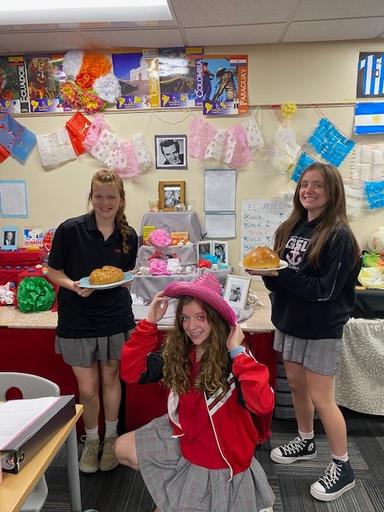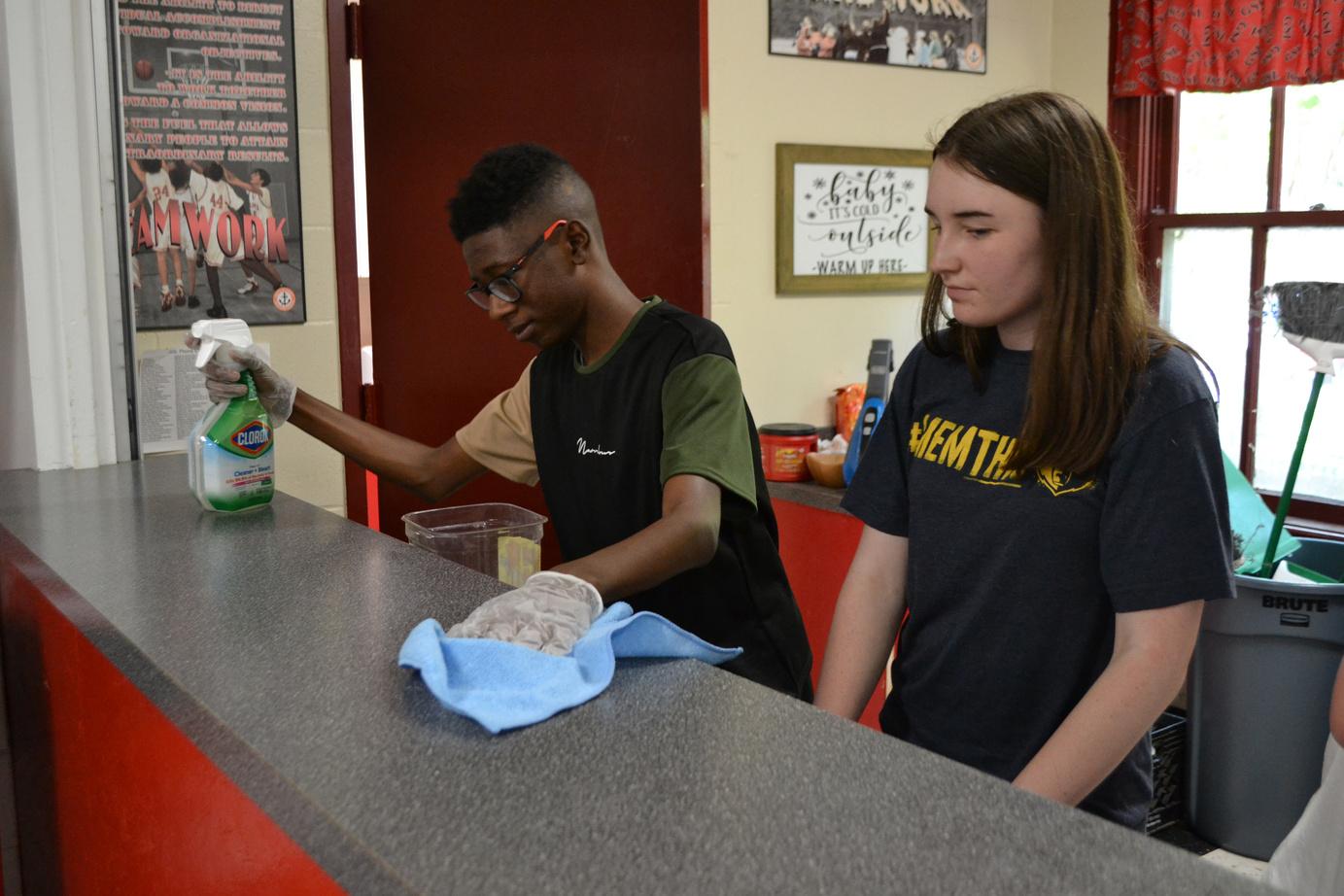8TH GRADE PROGRAM OF STUDY

2023-24 School Year




Mastering their language arts skills, eighth grade Lukers will develop a strong understanding of grammatical structures and mechanics of the language through frequent opportunities to write and examine writing. They will read a variety of texts, both fiction and non-fiction with an emphasis on understanding a variety of themes and historical contexts, including conflict and courage. Students will analyze short stories for characterization, point of view, plot, and theme, as well as satire, dramatic irony and allusion. Eighth graders will master parts of speech, types and parts of sentences, and the basics of writing conventions, including proper capitalization and punctuation. Eighth graders will apply research writing skills as they research a topic of their choice, producing a comprehensive, MLA-style research report as their capstone essay. The presentation of the 8th grade internships is another capstone experience.
An eighth grade Luker will read (both independently and through listening) a variety of thematic texts, both fictional and non-fictional, mastering fluency and comprehension as they analyze written work.
Acquire intellectual curiosity to enhance vocabulary usage
Deduce meanings and implications of vocabulary in literature and vocabulary book based on context, roots, prefixes, and suffixes
Analyze literature and interpret poetry
Understand and identify allusions, paradox, mood, satire, symbolism, bildungsroman, and allegory in literature
Collaborative discussions
Independent reading and writing
Shared Reading
Interactive read aloud
Apply reading for meaning skills
Project work
STAR Reading assessment
Accelerated Reader (A/R) testing
An eighth grade Luker will write frequently on a variety of topics with an emphasis toward providing evidence from the text in reading responses. They will undergo the writing process from developing an idea to drafting, revising, and finally publishing written work. They will develop writing beyond the single paragraph, paying attention to the organization of ideas and developing sentence fluency.
Write critical and persuasive paragraphs based on literature (poetry, novels, short stories) studied in class
Write a research paper in MLA format with bibliography which includes introduction to documentation and research techniques
Integrate appropriate literary quotes to effectively enhance a five paragraph essay
Improve clarity of syntax, usage, and effective transitions when writing.
Master all basic and some advanced word processing & spreadsheet
Collaborative discussions
Flexible groupings
Independent writing
Note taking
Secure a 3-day internship at local business by learning email/phone etiquette as well as note writing
Internship Fair develops public speaking and presentation skills
Opportunity to share writing
An eighth grade Luker will master grammar rules beyond parts of speech, including sentence structure (complements, phrases, clauses, sentence types), punctuation, and capitalization in order to follow formal writing conventions in their own writing. Students will use both ending punctuation and capitalization and apply skill in understanding of correct punctuation within the sentence.
Exit Outcomes
Develop strategies to better understand new vocabulary words, both in context and from direct instruction
Master parts of speech, parts of the sentence, phrases, clauses, verb and pronoun agreement, using pronouns correctly, capitalization, abbreviations, end marks, commas, colons, semicolons, and apostrophes
Deduce meanings and implications of vocabulary in literature and vocabulary text, based on context, roots, prefixes, and suffixes
Experiences that Support Learning
Collaborative discussions
Flexible groupings
Small group instruction
Independent writing
IXL
Interactive vocabulary practice using digital resources
An eighth grade Luker will have frequent and varied opportunities to present in front of an audience, including a capstone speech in front of the entire school and the presentation of their eighth grade internships.
Exit Outcomes
Master various presentation techniques
Acquire a three-day internship, write business letters/envelopes, review phone call techniques, thank you notes, create a poster, and give a presentation
Write, prepare, and present a capstone presentation
Experiences that Support Learning
Collaborative discussions
Flexible groupings
Small group instruction
Independent writing
Interactive vocabulary practice using digital resources
Eighth grade Lukers will expand their knowledge of algebraic relationships. They should gain a conceptual understanding of the difference between rational and irrational numbers. Students will study and apply square roots, cube roots, and scientific notation. They will delve deeper into the use of linear equations, including systems of equations, and functions. Students will also apply geometric concepts such as the Pythagorean theorem, transformations, and formulas for three-dimensional figures to solve real world applications.
Develop an understanding that numbers that are not rational are called irrational
Understand informally that every number has a decimal expansion; for rational numbers show that the decimal expansion repeats eventually or terminates, and convert a decimal expansion which repeats eventually or terminates into a rational number
Use rational approximations of irrational numbers to compare the size of irrational numbers locating them approximately on a number line diagram Estimate the value of irrational expressions such as π²
IXL
Small group instruction
Flexible groupings
Math talks
Collaborative discussions
Manipulatives
Know and apply the properties of integer exponents to generate equivalent numerical expressions
Use square root and cube root symbols to represent solutions to equations of the form x² = p and x³ = p, where p is a positive rational number Evaluate square roots of small perfect squares and cube roots of small perfect cubes Know that √2 is irrational
Use numbers expressed in the form of a single digit times an integer power of 10 to estimate very large or very small quantities and to express how many times as much one is than the other
Perform operations with numbers expressed in scientific notation, including problems where both decimal and scientific notation are used. Use scientific notation and choose units of appropriate size for measurements of very large or very small quantities
Graph proportional relationships, interpreting the unit rate as the slope of the graph
Compare two different proportional relationships represented in different ways
Use similar triangles to explain why the slope m is the same between any two distinct points on a non-vertical line in the coordinate plane; know and derive the equation y = mx for a line through the origin and the equation y = mx + b for a line intercepting the vertical axis at b
Analyze and solve linear equations and systems of two linear equations
Solve linear equations in one variable
Analyze and solve systems of two linear equations
Understand that a function is a rule that assigns to each input exactly one output & the graph of a function is the set of ordered pairs consisting of an input and the corresponding output
Compare properties of two functions each represented in a different way (algebraically, graphically, numerically in tables, or by verbal descriptions)
Know and interpret the equation y = mx + b as defining a linear function, whose graph is a straight line; give examples of functions that are not linear
Use functions to model relationships between quantities
Construct a function to model a linear relationship between two quantities; determine the rate of change and initial value of the function from a description of a relationship or from two (x, y) values, including reading these from a table or from a graph; interpret the rate of change and initial value of a linear function in terms of the situation it models and in terms of its graph or a table of values
Experiences that Support Learning
Differentiated instruction to support concept development
Digital resources for review, practice for mastery and introduction to new concepts
Small group instruction
Flexible groupings
Math talks
Collaborative discussions
Manipulatives
Investigate patterns of association in bivariate data
Construct and interpret scatter plots for bivariate measurement data to investigate patterns of association between two quantities; describe patterns such as clustering, outliers, positive or negative association, linear association, and nonlinear association
Know that straight lines are widely used to model relationships between two quantitative variables; for scatter plots that suggest a linear association, informally fit a straight line and informally assess the model fit by judging the closeness of the data points to the line
Use the equation of a linear model to solve problems in the context of bivariate measurement data, interpreting the slope and intercept
Investigate chance processes and develop, use, and evaluate probability models
Differentiated instruction to support concept development
Digital resources for review, practice for mastery and introduction to new concepts
Small group instruction
Flexible groupings
Math talks
Collaborative discussions
Manipulatives
Understand and describe the effects of transformations on two-dimensional figures and use informal arguments to establish facts about angles
Verify experimentally the properties of rotations, reflections, and translations
Describe the effect of dilations, translations, rotations, and reflections on two-dimensional figures using coordinates
Use informal arguments to establish facts about the angle sum and exterior angle of triangles, about the angles created when parallel lines are cut by a transversal, and the angle-angle criterion for similarity of triangles
Understand and apply the Pythagorean Theorem
Solve real-world and mathematical problems involving volume of cylinders, cones, and spheres
Differentiated instruction to support concept development
Digital resources for review, practice for mastery and introduction to new concepts
Small group instruction
Flexible groupings
Math talks
Collaborative discussions
Manipulatives
Focus on the foundations of chemistry as well as an introduction to physics
Compare physical properties of dry ice and water, focusing on atomic structures
Observe oxidation of steel wool
Learn to balance equations
Explore different types of chemical reactions

Test pH of various acids and bases
Learn difference between distance and displacement with different types of movement
Differentiated instruction to support concept development
Digital resources for review, practice for mastery and introduction to new concepts
Small group instruction
Collaborative discussions
Conduct Fluffiest Pancake Lab
Use MEL chemistry kits
Conduct lab to increase the “glow” of a glow stick
Create Rube Goldberg machines
Eighth grade Spanish is a continuation of the seventh grade curriculum. Students will learn additional verb tenses and vocabulary to expand their depth of conversation thereby increasing their proficiency level in written communication. As in seventh grade, students will be expected to devote significant time for practicing and studying the target language outside of class. This coursework is correlated with the second semester of Spanish 1 in high school. Students will take the National Spanish Exam level 1 in March.

Learn vocabulary for hobbies, sports, vacations, travel weather, seasons, months, clothing, and shopping
Learn commonly used stem-change verbs as well as verbs with irregular 1st person conjugation
Review present tense conjugation of verb estar to state conditions/emotions
Compare verbs “ser” and “estar”
Identify direct object pronouns and placement in sentences
Learn use and formation of present progressive tense
Identify direct objects and replace with correct pronouns
Identify differences between “saber” and “conocer”
Identify and use indirect object pronouns
Conjugate regular verbs in preterite tense
Incorporate demonstrative adjectives and pronouns in to writing
Culture focus: compare Barca and Real Madrid soccer clubs, construct Day of the Dead altars, learn about Cuba and its culture; watch Spanish movie La Vida Loca
Create Day of the Dead altars
View Spanish movies and fotonovelas and respond to prompts in Spanish webquests
Group and partner projets
Play review games such as Kahoot, Conjuguemos, and Quizlet
National Spanish Exam
Answer discussion questions in Spanish
Eighth grade Latin continues students’ study of the Latin language through vocabulary, grammar, and reading lessons, and Roman culture as it existed in first century Roman Britain and Alexandria.
Recognize 1st -5th noun declensions
Recognize present, imperfect, perfect, and pluperfect tenses
Understand more advanced Latin sentence structure including subordinate clauses
Infer definitions of English derivatives based on knowledge of Latin vocabulary
Differentiate between verb conjugations
Compare and contrast life in a “traditional” Roman city to life in Roman Britain and ancient Alexandria
Recognize and understand the use and translation of all Latin cases (Nominative, Genitive, Dative, Accusative, and Ablative)
Recognize the translation of all degrees of Latin adjectives (regular and irregular)
Review basic and learn more in-depth
Roman mythology
Differentiated instruction to support concept development
Digital resources for review, practice for mastery and introduction to new concepts
Flexible groupings
Collaborative discussions
Consistent practice in both new and learned concepts to reinforce a cumulative understanding of the language Projects relating to cultural topics
Celebratory Latin feasts
This course explores the history of America from the Civil War through modern times Students will study the events of this time period with the goal of reaching a conceptual understanding of how the past has shaped present day America.
Students will be able to:
Effectively compose essays that demonstrate historical knowledge and critical thinking skills
Successfully evaluate historical cause and effect
Understand the geography of history
Utilize strong notetaking skills
Confidently present on historical topics
Productively collaborate on historical topics with peers
Image analysis
Reading and analysis of primary sources
Differentiated instruction to support concept development
Collaborative discussions and projects
Map reading
Independent notetaking
Research based assignments
Creative writing to display historical knowledge
Exit Outcomes
This capstone class for 8th graders will help students consider the world around them

Increase student understanding of complex problems faced by society as well as examine and consider the array of perspectives around issues
Learn about and practice understanding of these perspective while learning and modeling civil discourse
Experiences that Support Learning
Small group and partner projects
Group presentations hone public-speaking and presentation skills
Collaborative discussions
Strengthen research, writing, and presentation skills
The guiding principles of the middle school visual art curriculum are the four C’s of 21st Century Learning: Creativity, Collaboration, Communication and Critical Thinking
Students develop these skills through artmaking, visual problem solving, discussion, and analysis of important artworks. Their artwork is hung for display at the end of each marking period with an opening reception for family and friends.

Eighth grade artists create a capstone project that incorporates both traditional and digital art media. They participate in the artistic process through research, planning, sketching, and development of technique.
Experiences that Support Learning
Watercolor technique development and review of art elements of principles
Choice-based watercolor paintings
“Tradigital” project that incorporates watercolor painting and type layout. Digital self-portrait for the annual auction project
Exit Outcomes
In response to several writing prompts, develop, write, and deliver a capstone speech to be given in front of the student body
Strengthen research, writing, and presentation/public speaking skills
The focus of the Middle School Physical Education Program is to foster an interest in and enjoyment of physical activity while promoting positive group interaction, good sportsmanship, and fitness These concepts are developed through a wide variety of activities with a progression of instruction based on age and skill complexity. The Middle School Physical Education Program incorporates skills and strategies for team and individual participation. The students are introduced to lifetime sports and fitness with skills being taught and developed through participation, practice, and game and fitness scenarios
Eighth grade students continue to build fitness with a progression from grade to grade in the complexity of aerobic and anaerobic exercises. At this level skills and game rules are emphasized for participation in team and individual sports
Internship
Eighth grade Chapel Talk speech
Athletic Banquet
SK Buddies
Co-curricular research paper in English and history
High School placement process
8th grade Downtown Scavenger Hunt

Continued leveled math
Special volleyball and basketball games
Special 8th grade privileges
Hands-on science projects
8th grade Portrait project